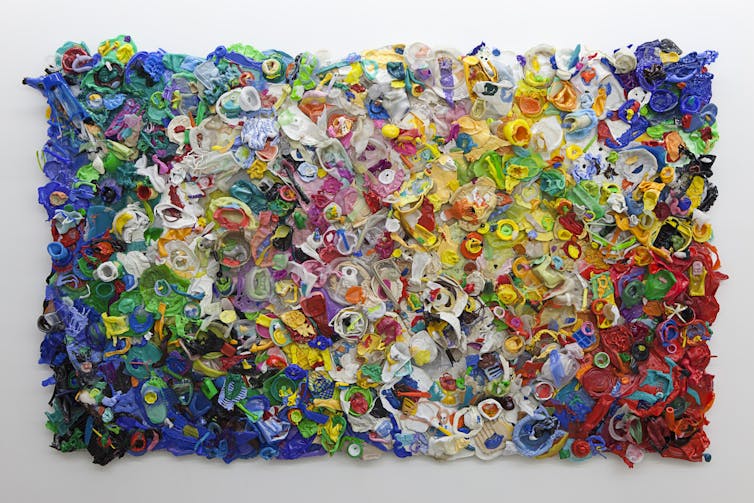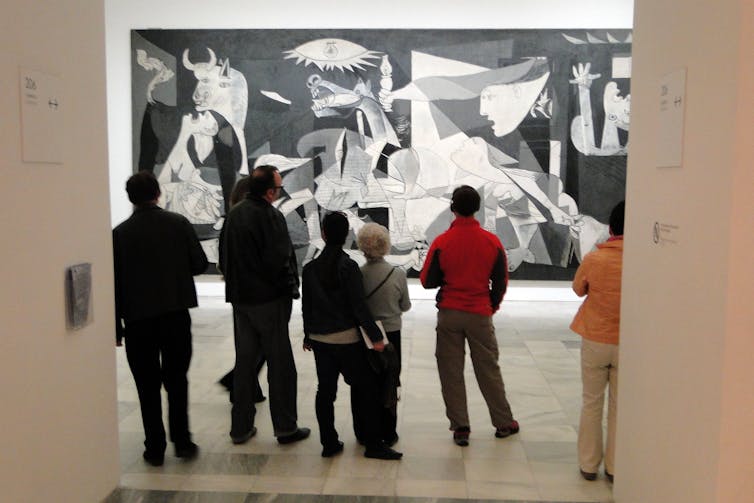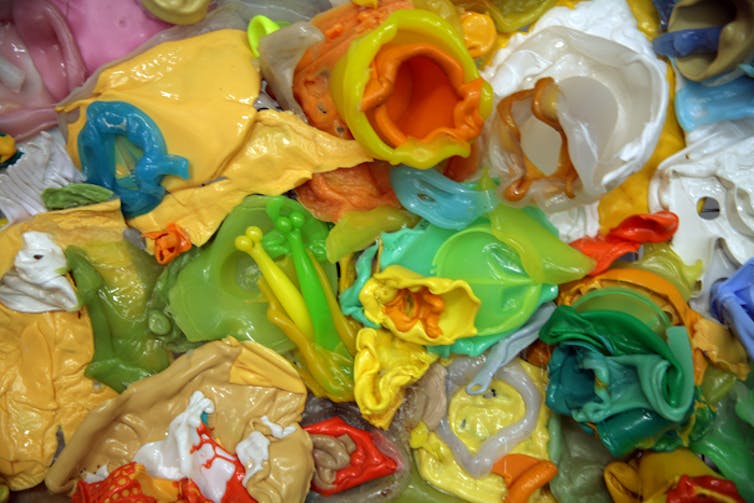What Does It Mean When It Asks for the Style of a Piece of Art
What's the central to agreement art? Could in that location exist some piece of cake steps to unpacking the pregnant of an artwork?
The short answer is: yes.
I recently wrote an article for The Chat chosen Three questions not to inquire of art – and 4 to ask instead, which tackled some age-old questions that get asked of art: Why is that art? What is it meant to be? Couldn't a four-year-onetime do that?
I suggested four better questions to ask, taken from Australian art bookish Terry Smith.
Here's a simple 3-stride method I use, adjusted from an old technique by the art historian Erwin Panofsky:
1) Look
2) See
3) Call back
The starting time two – look and see – are just about using your eyes, and observational skills. The third requires a chip of thought, drawing on what we already know and creatively interpreting what we've observed within an artwork's broader contexts.
When nosotros see annihilation, whether information technology's a work of art, a pic or a billboard, our brains perform a massively complex separate-second procedure of reading and making meaning. Nosotros absorb a whole range of clues that brand up our understanding of whatever image, many of which we're not even conscious of.
Any process of understanding art, then, is about slowing down that process, breaking downwardly the image deliberately and property off from jumping to any snap conclusions until later.
Stride 1: Look
Isn't it obvious nosotros "await" at art? Not really. When nosotros visit a gallery, we tend to spend just a few seconds in front end of any one work. In fact, some estimates accept it at under ii seconds.
So expect at what's there, literally right in front of you. Showtime with the most bones: what medium or material is it – a photo, an object, a painting? How does information technology look? Rough and quick? Slick and neat? Shiny? Dirty? Carefully made? Thrown together?
The artist will have fabricated some very deliberate decisions about the materials, style and approach, and these will feed directly into the overall feel and pregnant of the work.
Await at this work by Spanish-born Australian artist Dani Marti chosen Information technology'southward all about Peter, made in 2009.

It hangs on the wall similar a painting, but is made upwardly of hundreds of melted plastic objects bowls, orangish juicers, plastic domestic appliances, all different colours. Marti wants us to remember of it in the tradition of a painting, even if it's made up of 3D plastic objects.
Stride 2: See
What's the difference between looking and seeing in the context of fine art? Looking is about literally describing what is in front of you, while seeing is about applying meaning to it. When we see nosotros sympathize what is seen as symbols, and we interpret what's there in front end of us.
Erwin Panofsky calls the symbols in an artwork "iconography", and any prototype can be easily broken down into the iconography that makes information technology upwards.
Consider the iconography in Pablo Picasso's epic painting, Guernica (1937). In the centre, at that place'due south that screaming horse, with a dismembered arm just below information technology. On the left, a woman is wailing and holding a dead infant, and dominating the paradigm is the light shade that looks similar an explosion. Those individual elements combine to produce the overall meaning of the painting, which in this case is regarded every bit one of the most powerful anti-war fine art works created.

The iconography in Marti's It'southward all about Peter is not and then obvious – it's more abstracted, which ways it's removed from a simple literal depiction of something. But the actual melted plastic objects are everyday items – things you might take in your home, the objects a person would surround themselves with that brand up their life. Brand a mental note of iconography like this, and have information technology to the last footstep.
Step 3: Think
The final footstep involves thinking well-nigh what you've observed, cartoon together what you've gleaned from the first two steps and thinking about possible meanings. Importantly, this is a process of interpretation. It's not a scientific discipline. Information technology'southward not about finding the "correct answers", only about thinking creatively about the nigh plausible understandings of a piece of work.
The key here is context. The broader context of an artwork volition assistance brand sense of what you lot've already observed. Much of the information about context is usually given in those dull trivial labels that tell you the artist's name, the title of the work and the year. And there are often other valuable morsels of information included too, such as the identify and year an artist was born.

Who is the creative person? Is it someone whose work you lot know something most? If and so, what do you know about them? Even if this is "Picasso was a womaniser", or "Jackson Pollock was a drunk", if you've heard of the artist, you lot have some existing noesis y'all can bring to behave.
If y'all've never heard of the artist, what does his or her name suggest about where they might be from? Text panels in galleries usually have the artist's dates and where he or she was born. These are of import clues. Naturally, an artist born in the Soviet Union in the 1930s is going to have very different life experiences from one born in Kingdom of spain in the 1960s.
When was the piece of work made? What do you know virtually what was happening at the time, fifty-fifty if it's this year? Text panels sometimes say where the artist works, so where was the work made? Artists produce work that responds to the world they're immersed in every mean solar day, so the "when" and "where" volition give clues as to what was happening.
Importantly, bring to bear everything y'all know – you'd be surprised how much y'all know of the context of an artwork but from your general knowledge, a lot of which comes from conversations, television, the cyberspace, all those things that are "informal learning".
In the case of Marti's It'south all nearly Peter, the title is a major key. Marti is literally telling us that this work is all nearly someone called Peter. We might not know who Peter is, only we do know from the title that this is a kind of an abstracted portrait of him – think of how the artist has hung this on the wall like a painting, wanting the states to think of the tradition of portraiture.
The iconography – those everyday plastic objects in this piece of work – are a portrait of "Peter", perhaps things owned by him, that say something nigh the colours of the things he chooses to surroundings himself with. If this work was a person, what could you say about them? Colourful and complex, perhaps? We're guessing. Simply we've unlocked that It's all about Peter is a personal portrait about the creative person's connection with Peter.
Concur on …
You might be thinking, "hold on, if I did these three steps every time I see a work of art, it's going to accept years to see everything in the gallery".
So here's an of import tip – you don't have to wait at (or like) everything. You don't like those Old Master paintings of rich expressionless white people? Fine, don't waste your time on them. Alternatively, if y'all love that stuff and detest modern art, go wild.
Trying to come across everything in a major gallery in an hour is like going to a multiplex cinema and trying to see all 12 movies in an hour by dashing from theatre to theatre. Zippo would make sense.
Myself, I dear fine art that pokes me to remember differently most something I thought I already knew. Other people prefer centre processed. It'south all valid.
Only requite yourself a moment to dull down, to wait, run into and think, and you'll observe something that really speaks to you.
Source: https://theconversation.com/three-simple-steps-to-understand-art-look-see-think-33020
0 Response to "What Does It Mean When It Asks for the Style of a Piece of Art"
Post a Comment